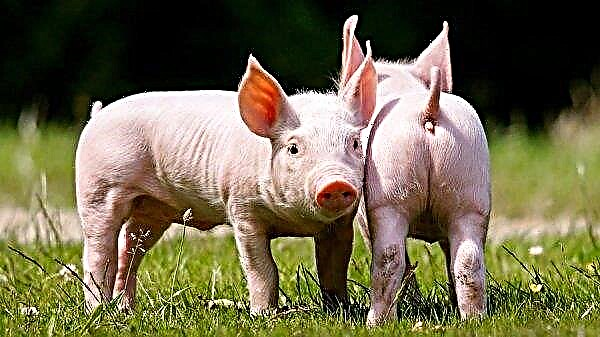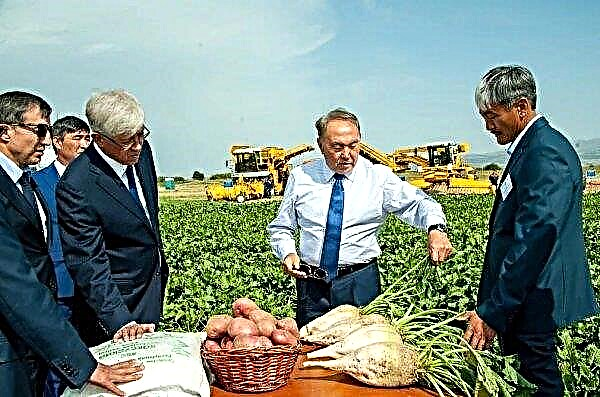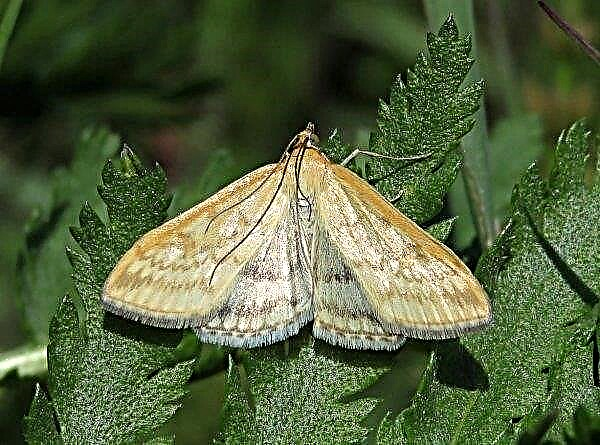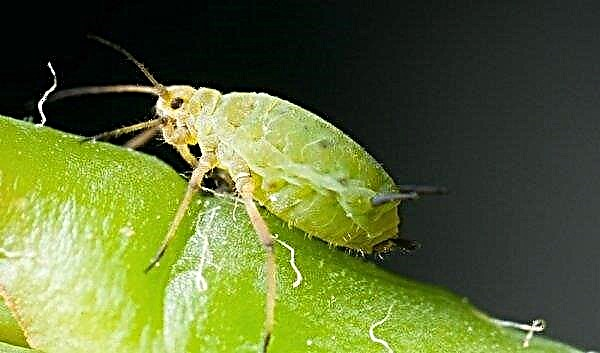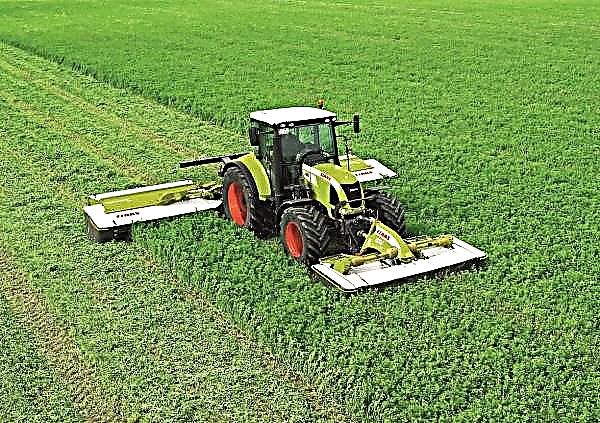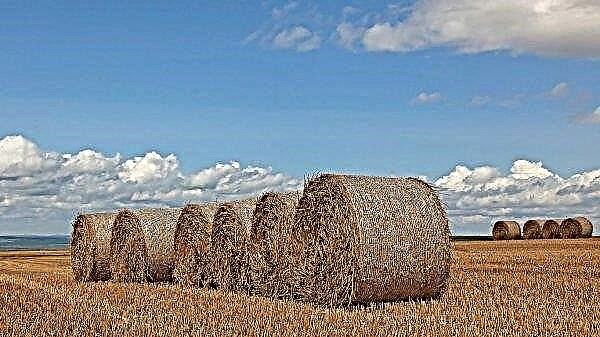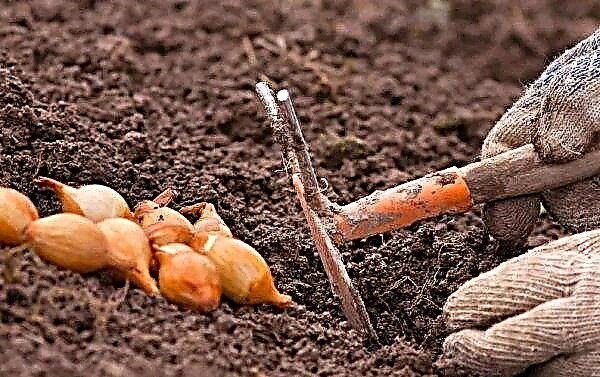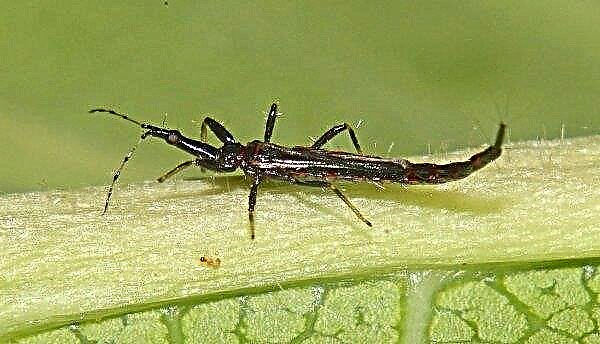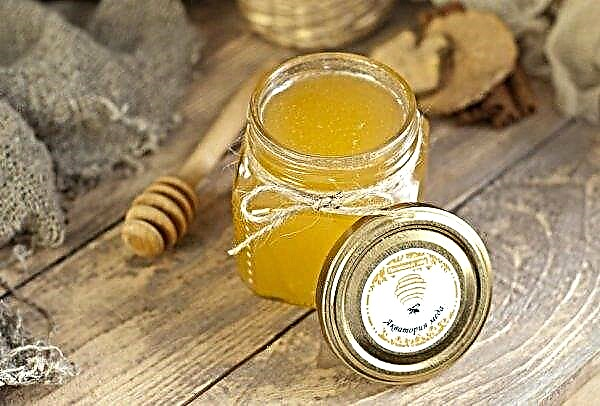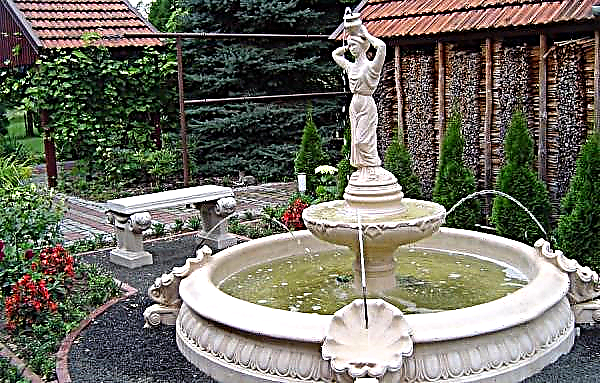Before choosing a potato variety, it is necessary to study as much information as possible about its requirements for care and cultivation features. Whether Lapot potato is suitable for your garden or summer cottage, our article will help you figure it out.
Selection history
Often this variety can be found under the name Siberian bast. It appeared as a result of folk selection in the 50s of the last century. About exactly which varieties participated in its creation is unknown. The variety quickly gained popularity among summer residents and gardeners. Attention to him does not stop today. By the way, one can meet such a point of view that the variety Lapot does not exist. Some agronomists claim that this is an American (Early Rose) modified in the process of growth in the wild.
Did you know? The largest potato in the world weighed 11.2 kg. She was raised by a farmer from Lebanon, Khalil Semkhat. The record was registered and entered in the Guinness Book of Records.
Description and characteristics of potatoes
The popularity of Lapot potatoes, in particular, is explained by the fact that it is a stress-resistant and hardy plant that is suitable for growing in risky farming regions - in Siberia, the Far East, Transbaikalia, etc. The variety forms medium-tall bushes - 50 –65 cm. There is always a lot of foliage on them. Plants bloom profusely with white flowers.

Tubers ripen in the medium term - from germination to harvesting 65–85 days pass. On one bush, 6 to 10 potatoes can be tied. The weight of one is 120-180 g. Often there are champions - 0.5-0.8 kg each and 20-25 cm long. The shape of a potato resembles a flattened oval. Their skin is pink, the flesh is yellow. Taste and commercial qualities are high. In cooking, tubers can be used for all purposes for which they use potatoes.
The average yield of the variety is noted at the level of 40–50 t / ha. Such indicators Lapot can show in adverse weather conditions, but with proper care. Bushes grow without problems during drought and in cold temperatures. Plants of this variety well resist the main nightshade diseases, however they are infected by late blight and alternariosis.
Advantages and disadvantages
- Potato Lapot is appreciated because of such advantages:
- a high level of productivity is stably recorded, which does not depend on weather conditions;
- very large and high-quality tubers are formed;
- the fruits have excellent taste characteristics;
- tubers perfectly tolerate transportation and long-term storage;
- the plant is well resistant to viral and bacterial diseases;
- the bushes do not have special requirements for soil, care.
Did you know? Potatoes were brought to Europe in the 16th century. At first it was declared a decorative and poisonous plant. And only in 1772, as a result of long-term research by agronomist Andre Permantier, potatoes were recognized as a nutritious and tasty vegetable. With her help, she managed to overcome hunger and scurvy in France.
- Among the shortcomings are worth noting:
- poor resistance to diseases caused by fungi;
- frequent wireworm;
- the difficulty of acquiring planting material.
Planting potatoes
To get the highest possible yield, you need to choose a suitable plot, observe crop rotation rules, plant tubers at the recommended times, correctly prepare the seed and soil, adhere to the planting technology.

The potato beds are made in a well-lit place. It is necessary to check that before this the following crops do not grow on it: potatoes, tomatoes, peppers. Well, if you can plant tubers after siderata, cucumbers, legumes, onions, cabbage, carrots, beets.
Optimal landing times
Tubers are placed in the ground when it is heated to a depth of 10 cm to + 8 ... + 10 ° С, i.e. it is impossible to indicate the exact date when to plant Lapot potatoes - this will depend on the climate of the region in which it is planted. The earliest planting of potatoes is at the end of March. In this case, it is cultivated under a film. Most often, landing is carried out in mid-April. In cold regions, this is done in early May.
Experienced gardeners do not use the measurement of soil temperature, but are guided by folk signs, one of which claims that the time for planting potatoes comes when the birch buds and flowers of the bird cherry are open.
Soil requirements
To the soil, the Lapot variety does not have any special requirements. Any land is suitable for it, but with two reservations: groundwater should lie no closer than 65–70 cm to the surface, and acidity should be neutral or slightly alkaline. If the soil is too acidic, in autumn it is necessary to add lime or dolomite flour, wood ash, and eggshell to it. This will reduce acidity.

In the fall, the selected area should be well cleaned of plant debris, dig deeply (to a depth of 20–25 cm) and fed with urea or manure, ash. If autumn processing is not possible, it is carried out in the spring - a few weeks before planting, dig holes, in which soil is fed with dry humus (1 l) with wood ash (1 handful), as well as nitrophos (1 tbsp. / 1 hole), ammophos ( 1 tbsp. L / 1 well), dolomite flour (0.5 tbsp. / 1 well). You can get by exclusively with organics by adding 2-3 handfuls of humus or rotted compost, a large spoonful of wood ash, a little chicken droppings and 3-4 pieces. peel of onion.
Important! The introduction of fresh manure into the holes before spring planting is strictly prohibited.
Preparing planting material
Lapot tubers must be germinated before being placed in the ground.

Preparation of planting material is carried out as follows:
- 30–45 days before the planned landing, it is taken out from a cool storage place to a room where the air temperature is maintained at + 13 ... + 16 ° С day and night, humidity - 90–95% and diffused light.
- Medium-sized, intact and unhealthy specimens with strong shoots up to 1 cm in length are selected.
- 3 days before placement in the wells, prophylactic treatment of pathogens and harmful insects in an aqueous solution of wood ash, means "Prestige" or "Epin-Extra" is carried out.
- For better germination, they are treated with “Kornevin” or “Heteroauxin”.
If there is not much time left before planting, then the germination process can be carried out in a shorter time. To do this, the tubers are placed in wet sawdust or peat, which previously underwent treatment with copper sulfate (2 g / 1 liter of water) or in three-liter bottles placed on a windowsill well heated by sunlight. Such procedures will allow to obtain sprouts after 20 days.
Landing technology
Potatoes Lapot planted in pre-dug holes. The optimal gap between them is 35–40 cm, between rows - 70–80 cm. The planting depth will depend on the composition of the soil. If it is light and loose, the tubers are deepened by 6–7 cm. In normal soil, planting material is laid to a depth of 7–8 cm. On heavy, clay soils, the optimum depth is 8–9 cm.

In cold regions, it is advisable to place a layer of rotted grass on the bottom of the hole - this will protect the tubers from freezing. 1-2 tubers are placed in each hole, after which the pits are completely covered with soil. Immediately carry out cultivation by a harrow or a rake. If climatic conditions require, the beds are covered with polyethylene or non-woven material to prevent exposure to cold.
Did you know? After the recognition of potatoes as edible, in many countries of Europe the monarchs had to encourage or threaten the peasants so that they began to grow it. So, in England they promised gold medals for cultivating a vegetable, and in Prussia they cut off ears and noses in case of disobedience.
Potato Care Features
Even a beginner in gardening can take care of potato bushes of the Lapot variety. Potatoes need a little attention, but care is still needed. It involves carrying out procedures such as soil moisture, loosening and weeding, hilling, fertilizing, preventive treatments against diseases and harmful insects.
Watering and fertilizer
The minimum amount of watering that a potato needs is 3 per season. So much moisture is needed if regular precipitation is observed. In a dry summer, their number will need to be increased and carried out 1 time in 4 days. Under 1 bush use 2.5-3 liters of water.
The first hydration should be done when the sprouts reach a height of 8–10 cm (approximately at the end of June). The second is required in the budding phase (in the middle of summer). Third, after the formation of tubers and their active growth (in early August). Potato bushes respond best to sprinkling. It is carried out early in the morning, so that before the sun begins to actively illuminate the garden, the leaves have time to dry.

Variety Lapot needs additional nutrition. It is best to introduce organic matter - mullein infusion, green fertilizer, bird droppings, wood ash. If this is not possible, then you will need to resort to the introduction of mineral fertilizers.
At the beginning of the growing season, plants need nitrogen, therefore, additives containing this element are added at this time. It can be ammonium nitrate or carbide. It will be necessary to dissolve 15–20 g in a bucket of water and pour soil with this solution in the near-stem circle. The fluid flow rate is 500 ml for each bush.
During fruiting, plants need phosphorus and potassium. At this time, they resort to top dressing with superphosphate (35–40 g), potassium sulfate (25–30 g). Granules are also diluted in a bucket of water. Boric acid (3-5 g), potassium permanganate (1-2 g), copper sulfate (1-2 g), zinc sulfate (1-2 g) can be added to the solution.
Important! The best yields are given by the potato that was grown using mineral and organic fertilizing in turn.
Weed cleaning
Important care activities are weeding and mulching. The first procedure avoids the development of many diseases and attacks of harmful insects. Weeds should be removed with the root. You need to do this regularly. Otherwise, they will cover potato bushes with such necessary sunlight and take away their nutrients.

It is possible to significantly reduce the number of weeds if the beds are mulched. As mulch use fresh grass, straw, peat crumb. Carrying out this procedure, you can "kill two birds with one stone": to prevent the growth of weeds and to maintain the necessary moisture in the soil.
Loosening and hilling
Mandatory procedures for caring for a vegetable plant are loosening and hilling. Loosen the soil a day after watering or rain. Loosening avoids the formation of a hard crust on the surface of the earth and improves its air and moisture conductivity. The depth of cultivation should be small - up to 3 cm.
At least 3 hills will be required during the season. They are needed to improve the development of the root system and protect young plants from the cold. The first time they spud a little grown seedlings. They are almost completely covered with soil. The second time the hilling is carried out during flowering. In the third - when the tops begin to spread. Sapa gently sprinkle the soil with a knoll to the stem, raking it in a radius of 25 cm.
Methods for eliminating pests and diseases
Plants of this variety are recommended to be processed in order to prevent damage to alternariosis and late blight. During the period when the leaves are closed, spraying with the contact fungicide “Shirlan” is necessary. Treatments are carried out once a week.
Prevention of late blight is carried out using folk remedies: spraying with infusions of garlic, kefir or whey, dusting with wood ash. Sheltering of beds with a non-woven material also helps.
Of the pests for potatoes, the following insects are dangerous:
- Wireworm - This is an insect, which is quite difficult to get rid of. Traps are used to fight, put onion peel or mustard powder when planting in a hole, use mixed plantings with green manure, resort to spraying with Provotox, Aktara, Barguzin, Prestige.
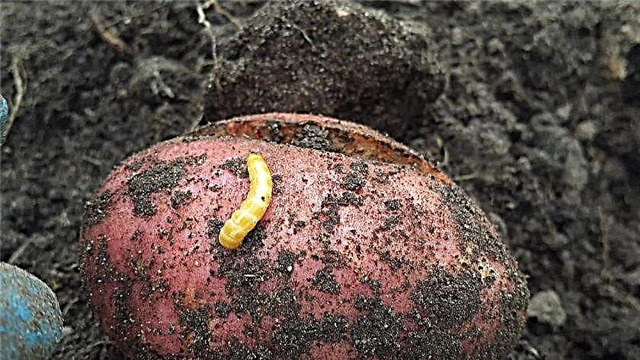
- Colorado beetle- It can cause serious damage to the crop in a short time. With little distribution, it is collected manually. With a massive lesion, they resort to treatment of bushes with urea (100 g / 10 l).
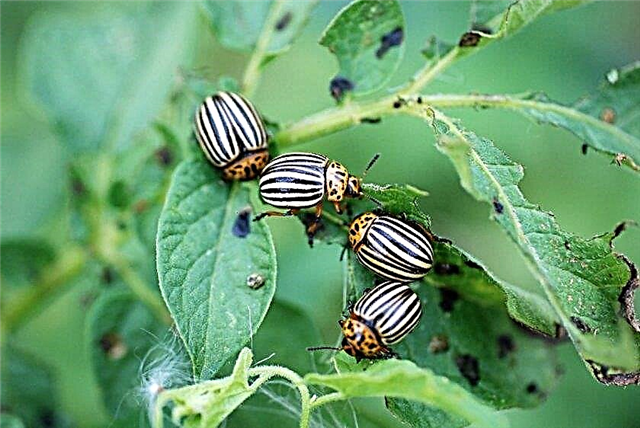
- Bears - heavily damage the tubers that are underground. Marigolds, calendula, chrysanthemums planted in needles spaced in the aisles, arranged in the area of the trap can scare them away from the beds. They fight with a bear biological ("Boverin", "Nemabakt") and chemical preparations ("Maxim", "Prestige").

Harvesting and storage
Harvest potatoes Lapot harvested from late August to late September. Tubers have very good shelf life - at the level of 94%, therefore, under the right conditions, potatoes can be stored until spring. They start cleaning as soon as the lower leaves turn yellow. Mass harvesting is carried out with yellowing of the tops completely.
Tubers extracted from the soil are first placed in bags, which are placed in a dark room with good air circulation and temperature indicators of + 15 ... + 20 ° С. As soon as 1-2 weeks pass, a thorough examination of the fruits and culling of those affected by diseases are carried out. The selected potatoes are lowered into storage. Optimum conditions for its preservation: temperature - + 3 ... + 5 ° С, humidity - 90–95%, good ventilation.
Did you know? In Peru, potatoes were determined by time. The Inca served as a measure of the time period that was spent on the tuber cooking. It was approximately one hour.
So, despite the fact that breeders in the XXI century have bred many excellent varieties, Lapot for almost 70 years has not lost ground and has many admirers among gardeners and summer residents. Its tubers are delicious, suitable for preparing any dishes, stored for a long time. Using simple care measures, you can achieve consistently high yields.





